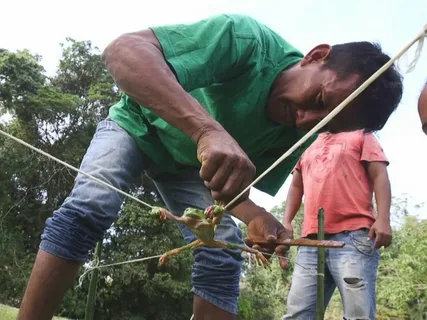Understanding Rapeh: Origins and Cultural Significance
Rapeh, pronounced “ha-peh,” is a traditional snuff made from a blend of finely ground medicinal plants, herbs, and tobacco, often used by Indigenous tribes in South America, particularly the Amazon basin. Its origins trace back to the ancient traditions of various Indigenous cultures, where it was utilized in spiritual ceremonies and as a means of healing. The preparation of rapeh involves meticulous crafting, where different plants are mixed to achieve specific effects, often tailored to the individual needs of the user. This snuff has a deep-rooted cultural significance, acting not only as a physical remedy but also as a spiritual tool to connect with nature, ancestors, and the universe. In many tribes, the ritual of sharing rapeh is a communal activity that fosters connection, support, and mutual understanding among participants.
The Healing Properties of Rapeh
Rapeh is renowned for its therapeutic properties, which have been celebrated for centuries. Its primary ingredients often include various herbs, such as medicinal plants with anti-inflammatory, analgesic, and detoxifying properties. When inhaled, the powdered blend enters the nasal passages, delivering a powerful combination of compounds that can promote relaxation, alleviate headaches, and reduce anxiety. Many users report an enhanced sense of clarity and focus, making it a popular choice for those seeking mental and spiritual rejuvenation. Additionally, rapeh is believed to support respiratory health by clearing mucus and facilitating deeper breathing. This natural remedy contrasts sharply with modern pharmaceuticals, which can come with unwanted side effects. The holistic approach of rapeh aligns with many Indigenous philosophies, emphasizing the importance of harmony between body, mind, and spirit.
The Ritual of Using Rapeh
The ritual of using rapeh varies among different cultures and communities, often involving a ceremonial aspect that enhances the experience. Traditionally, rapeh is administered through a pipe or a specially designed instrument called a “kuripe” (for self-administration) or a “tepi” (for use by another person). The act of sharing rapeh is steeped in tradition; it signifies trust and camaraderie. Participants often take turns inhaling the snuff, allowing for a profound exchange of energy and intention. The setting is typically serene, with an emphasis on creating a sacred space that encourages mindfulness and connection to the spiritual realm. Many users incorporate breathing techniques and meditative practices, further amplifying the healing effects of the snuff. This communal aspect of using rapeh fosters a sense of belonging and support, which can be profoundly therapeutic in itself.
The Modern Resurgence of Rapeh
In recent years, there has been a resurgence of interest in rapeh beyond Indigenous communities, as people seek alternative wellness practices that promote mental clarity and emotional balance. This growing popularity has led to a wider availability of rapeh in various forms, including pre-packaged blends and artisanal creations. Many practitioners and enthusiasts advocate for its benefits, often sharing personal testimonials of transformative experiences. However, this modern movement comes with ethical considerations; it is essential to honor the cultural roots of rapeh and ensure that its use respects Indigenous traditions. Education and awareness about the proper context and significance of rapeh can help bridge the gap between traditional practices and contemporary wellness trends. As more individuals explore the world of natural remedies, rapeh stands out as a powerful tool for healing and connection, inviting a deeper understanding of its cultural heritage and potential benefits.
Conclusion: Embracing the Spirit of Rapeh
Rapeh is more than just a traditional snuff; it is a powerful embodiment of cultural wisdom and healing practices that have withstood the test of time. Its origins reflect the rich tapestry of Indigenous traditions, while its therapeutic properties offer a holistic approach to wellness. As individuals seek to reconnect with nature and explore alternative healing methods, embracing rapeh provides an opportunity to foster community, enhance well-being, and honor the cultural significance of this ancient practice. In a world increasingly focused on mental health and emotional balance, rapeh invites us to embark on a journey of self-discovery, healing, and connection—both with ourselves and the world around us.



